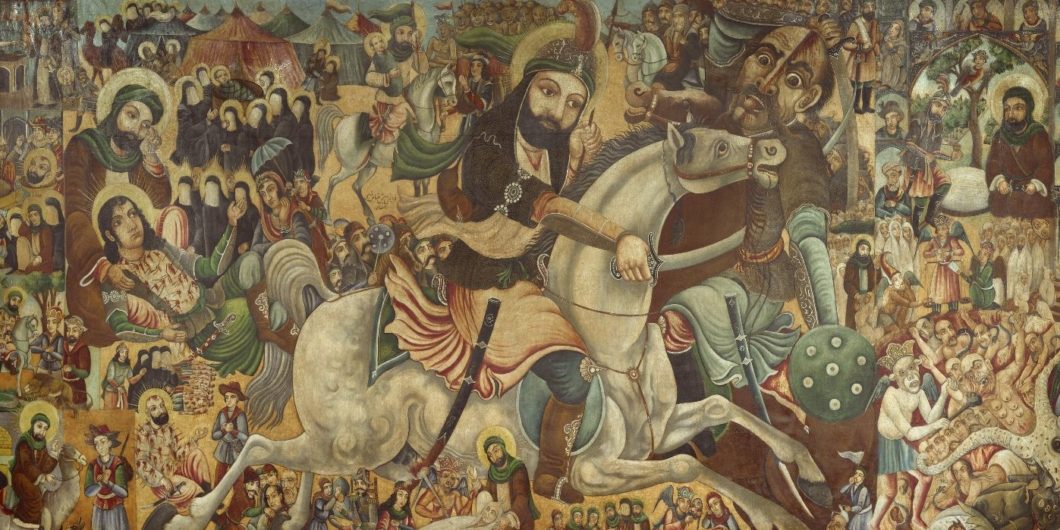One has to conclude that regarding Jefferson’s affinity to Islam and his possible inspiration from the Qur’an, there is no there there.
The Sunni-Shi‘a Split: Political and Religious
It is no great secret that coverage of Islam tends to favor Sunni over Shi‘a Islam, a trend that is puzzling in its persistence given geopolitical concerns of the past decade (indeed, of the past 40 years). Even in the academy, a glance at the Middle East Studies Association’s latest annual conference yields a total of six out of around 1000 total papers with “Shi‘a” or “Shi‘i” in the abstracts (though this is an admittedly imperfect measure). Laurence Louër’s Sunnis and Shi‘a: A Political History, then, provides a useful service to the field, not only in attending to the tradition of 15-20 percent of global Muslims who are Shi‘a, but also in bringing both major sects of Islam together in one comprehensive history. It is no small feat to create a political history of Islam, much less one that attends so well to Shi‘ism, in so few words, and I am aware of no other contemporary work that achieves this.
The book is divided into two parts, the first covering the history of the Sunni-Shi‘i split from the death of the Prophet Mohammad in 632 up to the modern era. This part takes readers through the years of Ottoman and Safavid imperial “rivalry” to the Sunni-Shi‘a “convergence” during European colonial years (Chapter Two is entitled “Rivalry and Convergence”). It then details the post-World War II rise of parallel-but-competing versions of Islamism (the Muslim Brotherhood, for the Sunni, and the Iranian clergy after the 1979 revolution, for the Shi‘a), and ends with the present geopolitical and sectarian rivalry between Sunni Saudi Arabia and Shi‘a Iran.
Part II devotes individual chapters to the key nation-states involved in the Sunni-Shi‘a “rivalry and convergence”: Iraq, Bahrain, Pakistan, Yemen, Lebanon, and Saudi Arabia and Iran (treated together in one chapter). This part is quite good, offering brief but informative narratives of the modern histories of each country’s Sunni-Shi‘i relations and returning to topics introduced somewhat cursorily in Part I. Highlights include a discussion of Pakistan’s transition from its quasi-secular founding as a to a formally Islamic state (Chapter Eight), parallels between Saudi Arabia’s Shi‘i minority and Iran’s Sunni minority (Chapter Nine), the ideological nuances and “political pragmatism” of the so-called Yemeni Imamate (Chapter Ten), and the influence of Maronite Christianity on historical Sunni-Shi‘a relations in Lebanon (Chapter Eleven).
Telling, Not Showing
The book is very much what it claims to be—a political history—and those looking for a strong theoretical or explanatory apparatus may be disappointed. The closest facsimile appears in the introduction, where Louër refers to the book’s “central argument” as the following: “Over the centuries, these controversies [over legitimate succession to the Prophet Mohammad] were activated or deactivated depending on the political context.” Beyond this statement, Louër’s brief conclusion draws out two “lessons”: first, that Sunni-Shi‘a relations have a “mimetic” pattern, each attempting to mirror its counterpart’s form or authority structure at various junctures in history, and secondly, that Sunni-Shi‘a relations “exhibit several classic characteristics of minority-majority relations.”
Perhaps as a result of such a cautious line of argumentation, the theoretical takeaway from the book appears to be quite open to interpretation: whereas Marc Lynch’s dust jacket blurb proclaims that Louër has provided “a convincing rebuttal to the notion of the inevitability of eternal sectarian conflict,” I could not find in her book strong evidence to suggest that the cycle of “rivalry and convergence” appears poised to change in the foreseeable future. While Louër does show that inter-sectarian cooperation has been possible at the emergence of greater threats (non-Muslim colonial powers, for instance), the overall account portrays sectarian conflict as deeply entrenched and open to manipulation (or “activation”) by—also deeply entrenched—political interests. Again, though, the overall argumentation is quite mild; Louër stops there, preferring to tell, rather than interpret, history.
The impulse. . . to assume that religion is the handmaid of political power not only fails adequately to explain history, it begs the question of what “political” means in the first place.
Of course, a history is rarely only a history, and below I discuss some of the ways in which Sunnis and Shi‘a seems to favor the salience of political factors while downplaying those that would typically be understood as religious. But first, a note on the book’s genre. Originally published in France, Sunnis and Shi‘a is best described as a specimen of haute vulgarisation, the French tradition of high-level popular reading, which, to the American reader, is effectively an academic book with light documentation. The characteristic lack of clunky qualifications, footnotes, and endnotes can in principle make a work accessible to the general reader, but perhaps due to this book’s sweeping breadth of historical coverage in just under 200 pages, the style is not exceptionally readable, with copious uses of “the latter” and “the former” that can be jarring for readers not already familiar with major and minor casts of characters in Islam from 632 to the present. Sunnis and Shi‘a is nevertheless packed with information, and the committed autodidactic general reader will benefit from the wealth of historical detail.
Still, light documentation comes with hazards. While one can assume that Professor Louër’s factual claims need not be called into question, without knowing her sources, readers may find that her interpretive moves beg for further justification. For example, in Chapter Six (“Iraq: On the Frontier of Sunnism and Shi‘ism”), Louër writes that “the ruling elites’ hostility toward the Shi‘a, whether under the monarchy or the republic, was without specifically religious foundation.” Rather, according to Louër, the “main problem, in [the elites’] eyes, was the real or supposed links between the Iranian state and the Shi‘a.” Louër’s judgment may well be the correct one, and she is consistent throughout the book in supporting the primacy of political, rather than religious, factors in explaining the persistence of the Sunni-Shi‘i rivalry. However, barring the documentation one would ordinarily expect from a work of history, the reader here must simply accept Louër’s claim on the authority of the scholar. I may be guilty of criticizing a book for its genre, but with a bibliography of exclusively secondary sources and scant attention to the plausible claim that “specifically religious” factors may play a real role, it is difficult to know whether to trust this interpretation.
A Political—Not Religious—History
Louër’s treatment of Iraqi motivations points to a more substantive dispute. In denying the presence of “specifically religious factors,” which seems to be a persistent interpretive thread, Louër is inviting the question of what such factors would be—and whether one can separate religious from political factors in Sunni-Shi‘a rivalries.
The early chapters of the book deal, quite naturally, with the competing claims for religious authority after the death of the Prophet Mohammad. According to those who would become Shi‘a, the Prophet designated his son-in-law ‘Ali as his successor as caliph (i.e., the supreme political and religious leader)—a claim the Sunni deny. ‘Ali, therefore, did not get his turn at being caliph until three caliphs (the three other so-called “rightly-guided” caliphs Abu Bakr, ‘Umar and ‘Uthman) had intervened. What is crucial for my point here, though, is that after ‘Ali’s death, the Shi‘a conception of the imam developed, taking on an additional, specifically religious meaning, one that contained not only the authority to rule in religious matters but to serve as an interpreter of God’s message: in Louër’s words, “While the prophet is responsible for transmitting the obvious meaning of God’s message to as many people as possible, the Imams are tasked with revealing its hidden meaning to an elite by virtue of their intimate relationship with God.”
By contrast, according to Louër the Sunni conception of “imam” is essentially interchangeable with “caliph,” which literally means “successor,” but which designates the political and religious leader of the Muslim community. This superadded role of the Shi‘a imam as compared with the Sunni caliph touches on a doctrinal dispute of monumental importance: although along with the Sunni, “the Shi‘a adhere to the fundamental dogma of Islam according to which Muhammad is the last of the prophets sent by God (khatimiyya) and thus do not present the Imam properly speaking as a prophet (nabi or rasul in Arabic),” still, “the [Shi‘i] Imam nevertheless possesses all attributes of a prophet according to the classic terms of religious sociology: in personal contact with God, he reveals divine secrets, is exempt from sin, and has infallible judgment (ma‘sum).” One is tempted to see in this picture shades of the difference between, say, the Protestant English monarch who, like the caliph, holds (at least historically) both political and ecclesiastical authority, but does not speak for God in forming doctrine, versus the Roman Catholic pope who, like the Shi‘i imam, holds doctrinal interpretive authority. The parallel is hardly perfect, but the point is that this dispute between Roman Catholics and Protestants is typically not understood as “absent specifically religious foundation,” for, as with the differences in conceptions of the imamate, at its heart is the question of who speaks for God.
Louër’s treatment of ISIS similarly downplays the salience of religious factors and accents the importance of political forces. After only two paragraphs on the rise of ISIS (“Daesh,” for its Arabic acronym), she concludes Chapter Six with the following: “Daesh is thus less a consequence of the massive spread of jihadist Salafist ideology in Iraq than a symptom of Iraq’s failed political transition.” But surely it is both; that the failed political transition provided a power vacuum does not explain why so many thousands would volunteer as potential martyrs for a cause so manifestly Salafi, i.e., religiously ideological. (Louër’s response to this is that “only a small minority of Muslims subscribe to that [jihadist-Salafist] doctrine, a fact that naturally reaches its limits.”) And again, beyond my substantive disagreement, it is somewhat frustrating to be asked to accept this interpretation without further documentation, for Louër discusses only the failed political transition and does not discuss, in any depth, the spread of jihadist Salafi ideology. Naturally, then, the reader will be inclined to agree with her conclusion, as her selection of evidence presents it as the only one.
Perhaps this doesn’t matter; perhaps it is beyond the scope of a political history to consider religion as well. If so, however, then it is beyond its scope to dismiss religious factors out of hand. But then one must ask whether a political history of a religious schism—the book is, after all, called “Sunnis and Shi‘a,” both of which are sects of a religion—can fairly treat religion as beyond its scope. To use an imperfect parallel, would a political history of the United States that treated “specifically religious” matters as epiphenomena be considered complete? Were Puritan covenantal beliefs effectively proto-Lockean social contract theory, for instance, or was the anti-Catholic sentiment of the late 19th and early 20th centuries only nativist racism with no specifically religious foundation? (Even if the answers were “yes,” that judgment would need justification.) The impulse, so common in the social sciences and history, to assume that religion is the handmaid of political power not only fails adequately to explain history, it begs the question of what “political” means in the first place. It may well be that some human motivations that affect politics cannot themselves be captured by, or reduced to, political factors.
In short, Sunnis and Shi‘a: A Political History, while highly informative and certainly increasingly timely, replicates a tired pattern one finds across the social sciences, namely, a presumption that when motives are mixed between religion and politics, religion is always the tool of politics. But how do we know it is not the other way around? Louër’s book therefore provides excellent historical work of what has happened but leaves the reader wanting for an explanation of why.



